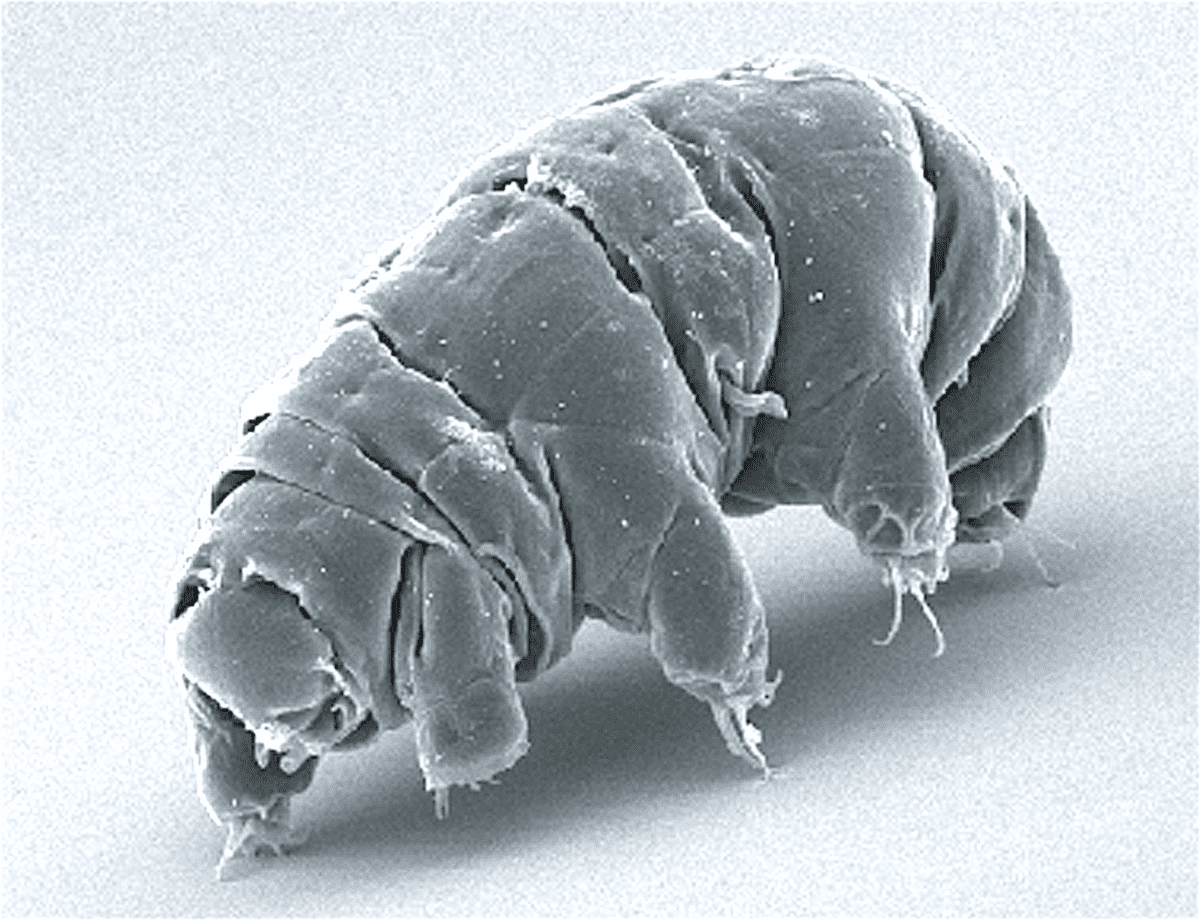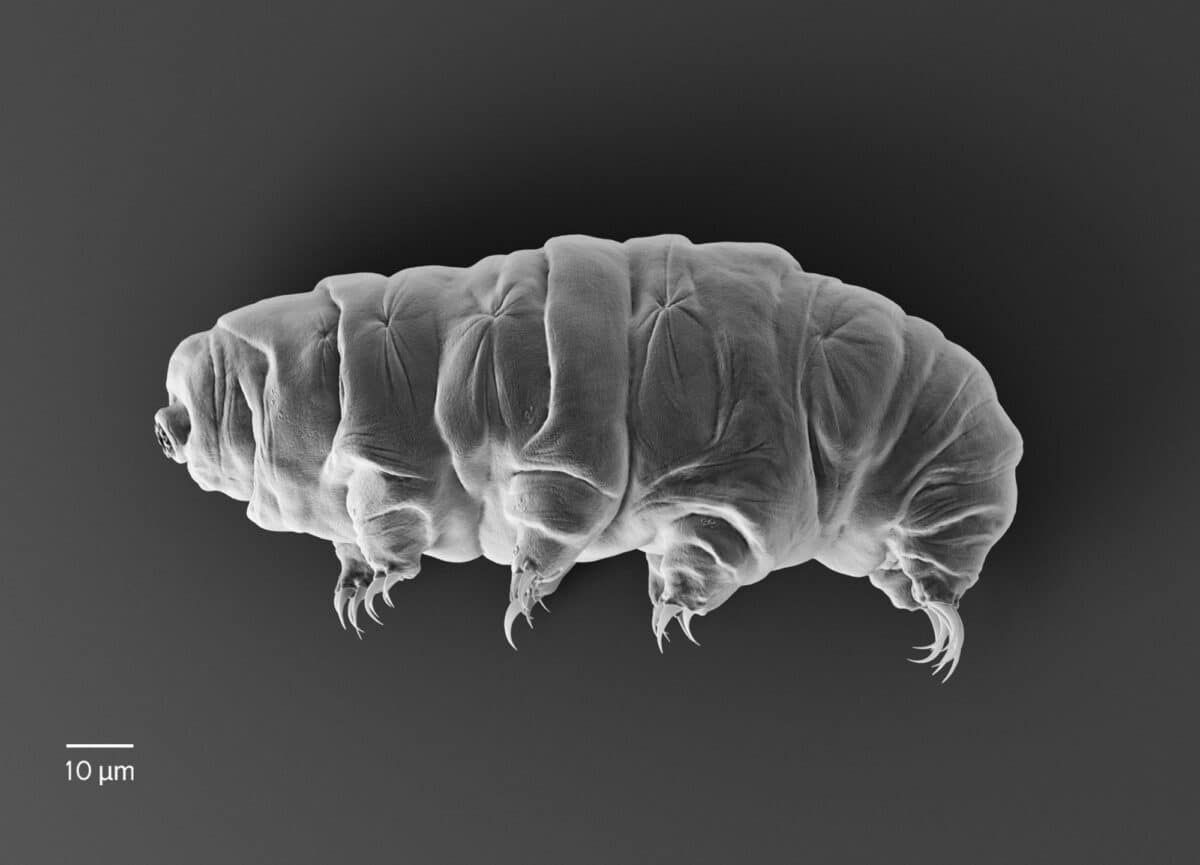In the spectrum of Earth’s creatures, from the mighty blue whale to microscopic bacteria, one tiny organism stands out for its extraordinary resilience: the tardigrade. Often called water bears or moss piglets, these minuscule animals measuring less than a millimeter have captured the imagination of scientists worldwide with their seemingly supernatural ability to survive conditions that would obliterate most life forms. While humans worry about climate change and nuclear threats, tardigrades quietly demonstrate survival capabilities that could allow them to endure even planetary catastrophes. Their remarkable adaptations provide a fascinating glimpse into extreme survival mechanisms that have evolved on our planet—and might just make tardigrades the last Earthlings standing when the apocalypse arrives.
The Remarkable Anatomy of Earth’s Toughest Creature

Tardigrades may be tiny, but their anatomy is perfectly engineered for survival. These eight-legged micro-animals belong to the phylum Tardigrada, which includes over 1,300 known species. Their tubby, segmented bodies typically range from 0.1 to 1.5 millimeters long, requiring microscopes for proper observation. Each tardigrade possesses four pairs of legs ending in multiple claws or suction discs that help them navigate their microscopic terrain.
Their body is protected by a flexible cuticle that periodically molts as they grow. What makes their anatomy particularly special is their lack of respiratory and circulatory systems—instead, gas exchange occurs directly through their body surface. This simplified physiology contributes significantly to their ability to enter suspended animation when conditions become unfavorable, as fewer complex systems mean fewer vulnerabilities during extreme stress.
Masters of Cryptobiosis: The Death-Defying Trick

The tardigrade’s most extraordinary survival skill is cryptobiosis—a state of suspended animation where all measurable metabolic processes come to a near-complete halt. When facing extreme conditions, tardigrades perform a remarkable transformation by retracting their head and legs, expelling almost all water from their bodies, and reducing their metabolism to less than 0.01% of normal. This desiccated form, called a “tun,” can remain viable for decades.
During cryptobiosis, tardigrades produce special proteins and sugars, including trehalose and specialized intrinsically disordered proteins called Tardigrade-Specific Intrinsically Disordered Proteins (TDPs). These substances replace water in their cells and form a glass-like matrix that prevents cellular damage. The ability to essentially “turn off” life processes and then resurrect when conditions improve represents one of the most impressive adaptations in the animal kingdom—and a key reason these creatures could potentially outlast global catastrophes.
Surviving the Vacuum of Space

Perhaps the most astonishing demonstration of tardigrade resilience occurred during space experiments. In 2007, European researchers sent dehydrated tardigrades into low Earth orbit on the FOTON-M3 mission, exposing them to the vacuum of space and solar radiation for 10 days. Upon return to Earth and rehydration, many of the tardigrades successfully revived and even reproduced normally. The vacuum of space, with its near-absolute zero temperatures and absence of pressure, would instantly kill most organisms.
Yet tardigrades survived these conditions along with levels of radiation that exceed what would be experienced during most apocalyptic scenarios on Earth. The 2011 TARDIS experiment aboard the International Space Station further confirmed their space-hardiness. These successful space survival demonstrations suggest that tardigrades could potentially survive scenarios like asteroid impacts or supernovae radiation bursts that might otherwise sterilize Earth’s surface.
Radiation Resistance Beyond Human Comprehension

In an age of nuclear weapons and power plant disasters, radiation resistance becomes a critical survival factor. Tardigrades possess exceptional radiation tolerance that far exceeds human capabilities. While a radiation dose of 5-10 Grays (Gy) would be lethal to most humans, tardigrades can withstand doses exceeding 4,000 Gy in their hydrated state and up to 5,000-6,000 Gy when dehydrated.
This remarkable resistance stems from a protein called Dsup (Damage Suppressor), which physically shields DNA from the effects of radiation by binding directly to it. Additionally, tardigrades possess highly efficient DNA repair mechanisms that quickly fix damage when it does occur. These adaptations would allow tardigrades to survive radiation from nuclear war, solar flares, or even nearby supernovae—apocalyptic scenarios that would eliminate most other life forms, including humans.
Temperature Extremes: From Boiling to Freezing

Temperature extremes represent another domain where tardigrades demonstrate exceptional survival capacity. These microscopic survivors can withstand temperatures from near absolute zero (-458°F/-272°C) to well above boiling (300°F/150°C), though not indefinitely at these extremes. Their heat tolerance is particularly impressive—some species can endure brief exposure to 151°C (304°F), temperatures that would denature proteins in most organisms.
At the cold end of the spectrum, tardigrades survive through various mechanisms, including the production of cryoprotectant molecules and specialized proteins that prevent ice crystal formation within their cells. This temperature resilience would serve them well during climate catastrophes, volcanic winters, or even scenarios where Earth’s atmosphere is significantly altered. While most complex organisms have narrow temperature windows for survival, tardigrades’ broad tolerance would allow them to persist through thermal fluctuations that would eliminate most other species.
Pressure Tolerance: From Deep Ocean Trenches to Mountain Peaks

Tardigrades demonstrate extraordinary pressure tolerance that would help them survive drastic environmental changes. These micro-animals can withstand pressures six times greater than those found in the deepest ocean trenches (Mariana Trench) and can also survive in the near-vacuum conditions of high altitude or space. Research has shown they can endure pressures exceeding 6,000 atmospheres—the equivalent of being 87,000 feet underwater—conditions that would crush most organisms.
This adaptability comes from their flexible cellular structures and protective biochemistry that maintains cellular integrity under extreme compression or expansion. In apocalyptic scenarios involving massive oceanic changes, atmospheric pressure fluctuations, or even impacts that temporarily alter Earth’s pressure conditions, tardigrades would have a significant survival advantage over pressure-sensitive organisms. This adaptability across the entire pressure spectrum found naturally on Earth—and beyond—showcases why these creatures could persist through catastrophic planetary changes.
Outlasting Cosmic Threats to Earth

When considering threats from beyond our planet, tardigrades again emerge as potential survivors. In a 2017 study published in Scientific Reports, researchers examined tardigrades’ chances of survival against three potential extinction-level events: asteroid impacts, supernovae, and gamma-ray bursts. The analysis concluded that tardigrades would likely survive all but the most extreme scenarios. For example, while an asteroid large enough to boil away Earth’s oceans would eliminate tardigrades, most realistic impact scenarios would leave pockets of habitable environment where these creatures could persist. Similarly, only supernovae occurring extremely close to our solar system (within 0.14 light-years) would generate enough radiation to eliminate all tardigrades. This research suggests that tardigrades are likely to outlast humanity and most other complex life in the event of cosmic catastrophes, with their abilities to withstand the resulting environmental changes giving them an evolutionary edge when facing threats from outer space.
Desiccation Survival: Life Without Water

Perhaps the most counter-intuitive of tardigrade abilities is their capacity to survive almost complete dehydration—a state that would kill most organisms within hours. When facing dry conditions, tardigrades can lose over 95% of their body water and enter anhydrobiosis, a specific form of cryptobiosis. During this state, they replace water in their cells with trehalose sugar, which forms glass-like structures that protect cellular components and prevent damaging crystallization.
Their metabolism slows to nearly undetectable levels, and their bodies contract into the barrel-shaped tun. Remarkably, tardigrades can survive in this desiccated state for up to 30 years, reviving within hours when exposed to water. This ability would prove crucial during global drought scenarios, climate change-induced desertification, or other apocalyptic events that eliminate water availability. While most life on Earth requires regular water access for survival, tardigrades can simply wait out extended dry periods that would cause mass extinction of water-dependent species.
Chemical Warfare Survival: Resisting Toxins

Beyond physical stressors, tardigrades display remarkable resistance to chemical toxins that would be lethal to most organisms. Research has demonstrated their ability to survive exposure to various environmental toxins including heavy metals, pesticides, and other pollutants at concentrations far above what most animals can tolerate. While not completely immune, their detoxification mechanisms, protective cellular structures, and ability to enter cryptobiosis when exposed to harmful chemicals provide significant protection.
This chemical resilience would prove valuable during scenarios involving industrial disasters, chemical warfare, or pollution-related apocalypses. In a post-apocalyptic landscape potentially contaminated with various toxins released from damaged infrastructure or deliberate chemical attacks, tardigrades would continue to persist while more chemically sensitive organisms perished. This versatility in handling chemical stressors represents another dimension of their impressive survival toolkit.
Evolutionary Persistence: Ancient Survivors

Tardigrades are living testimony to evolutionary endurance, having existed on Earth for over 500 million years—surviving all five major mass extinction events that eliminated countless other species. Their lineage predates most animal groups alive today, emerging during the Cambrian period when complex life was just beginning to diversify. This evolutionary persistence demonstrates not just theoretical survival capability but proven staying power through actual catastrophic events including asteroid impacts, supervolcano eruptions, and dramatic climate shifts.
Tardigrades have witnessed the rise and fall of dinosaurs and countless other dominant species. Their long evolutionary history reflects their adaptability to changing planetary conditions and ability to persist through environmental upheavals that eliminated seemingly more robust organisms. This track record of survival through Earth’s most challenging periods provides empirical evidence supporting their potential to weather future apocalyptic scenarios.
Reproductive Adaptability: Life Finds a Way

Tardigrades possess reproductive strategies that further enhance their survival odds during catastrophic events. Many species can reproduce through parthenogenesis—a form of asexual reproduction where females produce viable eggs without fertilization. This ability means that even a single surviving tardigrade could potentially restart a population after a mass extinction event. Additionally, some tardigrade species can enter a state of suspended animation while carrying eggs, effectively preserving the next generation until conditions improve.
Their reproductive cycle is relatively rapid, with some species able to produce a new generation within 5-10 days under favorable conditions. Tardigrades also demonstrate phenotypic plasticity, allowing their offspring to develop characteristics suited to current environmental conditions. These reproductive adaptations collectively ensure population resilience during catastrophic events and rapid population recovery afterward, giving tardigrades a significant advantage over species with more complex or less adaptable reproductive requirements.
The Limits of Invincibility: What Could Actually Kill All Tardigrades

Despite their impressive survival abilities, tardigrades are not truly invincible. Scientific analysis suggests several scenarios that could potentially eliminate all tardigrades on Earth. The most likely would be events that completely vaporize or sterilize Earth’s oceans, such as the sun expanding into a red giant (which will eventually happen but not for billions of years), or an impact from a planetary-sized object large enough to completely boil away Earth’s water. Other potential tardigrade exterminators include nearby gamma-ray bursts of sufficient intensity or supernovae occurring extremely close to our solar system.
However, these events are exceedingly rare—the nearest potential supernova candidates are currently much too far away to threaten tardigrade survival. Even nuclear war, climate change, or asteroid impacts within realistic parameters would likely leave some habitable niches where tardigrades could persist. Their vulnerabilities exist primarily in scenarios so extreme they would render Earth completely uninhabitable for all life forms, not just selective extinction events that might eliminate more complex organisms like humans.
Conclusion: The Last Survivors of Earth

Tardigrades represent nature’s ultimate survivors—microscopic testament to the incredible adaptability of life on Earth. Their multifaceted survival toolkit, from cryptobiosis to radiation resistance, enables them to endure conditions that would eliminate virtually all other multicellular life forms. While humans and other complex organisms remain vulnerable to numerous extinction threats, from nuclear war to climate disaster, these resilient micro-animals would likely persist through all but the most extreme scenarios. The tardigrade’s remarkable evolutionary journey provides valuable insights into the limits of biological resilience and potential adaptations that might help other species, including humans, better withstand environmental challenges. As we contemplate our own species’ vulnerability to various apocalyptic scenarios, perhaps we should look to these humble water bears—Earth’s designated survivors—for inspiration about how life persists against seemingly impossible odds.
- This Fish Has the Most Teeth in the Ocean—And Uses Them Well - August 9, 2025
- How Wolves Use Group Howls to Reunite With Pups - August 9, 2025
- 12 Dog Breeds That Form the Deepest Emotional Bonds with Their Owners - August 9, 2025

